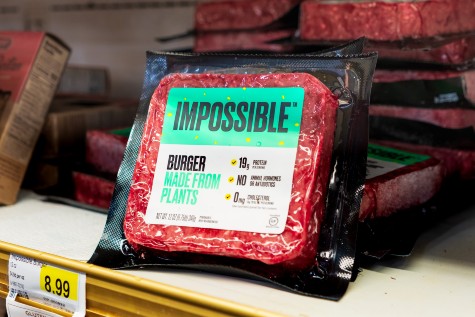New Solutions to Safely Extend the Shelf Life of Foods
By Lauren Solar
In this era of globally available fresh foods, both producers and consumers appreciate things that can extend the shelf life of products. At the same time, consumers demand “clean” foods, without a lot of chemical-sounding additives, and “green” packaging. Meeting these objectives while maintaining food safety is a challenge.
New technologies are striving to help producers achieve these sometimes-conflicting goals. Three key areas being addressed are new packaging options, new additives and new food treatment methods.

New Packaging
StePac, based in Isreal, has extended their line of modified atmosphere packaging (MAP) to include a resealable lidding film for fresh produce. This extends the shelf life of produce long enough to allow fruit from South America to reach retailers in China, while still at the peak of freshness.
Advanta, a UK based company, is marketing a combination aluminum tray and skin packaging product that can extend the shelf life of poultry by up to 300%. The chicken-shaped tray can then be used by the consumer to bake the chicken, without ever touching it, and the tray is recyclable.
Smart packaging doesn’t necessarily extend shelf life, many of these new technologies help alert consumers as to when a product is inedible. For example, Mimica, another UK based company, has developed a bioresponsive gel that gets lumpy when food begins to go bad. Consumers can touch the outside of the package and determine whether the food inside has spoiled. This also gets rid of the need for a best before date. CEO Laurence Kayson states: ‘We are currently working with market-leading EU and US food and drink producers to have fully scaled adoption later this year and growing fast into 2022, which will be a huge year for us and our mission to radically reduce food waste around the world.’
New Additives
Kemin, a global food industries company, has developed an alternative to EDTA (a common food preservative) that is plant based. Using extracts from rosemary and green tea, they have created an effective antioxidant that doesn’t affect the taste of the product.
Another example is Winecrush, a British Columbia agritech company that has partnered with many of the area’s wineries to turn pomace and lees from winemaking into a food flavouring ingredient. “Our patented new process reduces costs by 90% while doubling the nutritional value,” says Kirk Moir, the company CEO. “Thanks to the antioxidant properties of the polyphenols found in our new product, shelf life of some food formulations can be extended by as much as 60%. The old process lowered polyphenol content and carried over the astringency of red wine; our new process avoids these problems.”
Other food-waste based additives are being investigated as produce coatings. For this, as has historically been the case with pomace, the main challenge is creating an efficient and cost-effective process that does not affect the flavour.
New Food Treatment Methods
Probiotics soon may not be only for your own gut-health: companies and universities are investigating the usefulness of introducing “good” bacteria that will crowd out or defeat the bacteria that cause food-borne illnesses.
While high pressure processing (HPP) has been around for almost two decades, incorporating the machines into food processing lines has been a challenge. Hyperbaric, the world leader in HPP packaging, has now installed over 300 machines on five continents. They have also expanded their line to include bulk packaging options.
The National University of Singapore has been experimenting with exposing food to blue LED light. Research shows that this kills listeria and E. coli on the surface of foods, but they haven’t discovered how far the light penetrates, as of yet.
Dr. Keith Warriner, a professor of Food Science at the University of Guelph, has been researching hydroxyl-radical generation to clean produce. The process uses ultraviolet light, vaporized hydrogen peroxide and ozone. This process kills up to 99.99% of pathogens. It is more effective and consistent than traditional cleaning methods. “These radicals have a fleeting existence,” explains Dr. Warriner, “but are the most powerful oxidants known: more than bleach, more than ozone itself, more than chlorine dioxide.” Since the process is very quick, it doesn’t affect the texture or taste of the produce. Now Clēan Works Corp. in Beamsville, Ontario has created a commercially viable hydroxyl-radical generator.
Cold plasma treatment is another exciting new technology that is being used to preserve freshness. This treatment uses ionized gases which kills surface microbes. In-package treatment, where the treatment is applied to inert gas injected into the food packaging, is the newest exciting development. Research is ongoing to determine the best gases and treatment lengths for different foods. Scaling the process up to commercially feasible levels will require further advancements. Finally, the effect of the process on taste, texture and appearance of different foods, especially fresh produce and raw meat, is still being investigated.
“There’s always new technology coming,” observes Jeff Hall, Food Safety Specialist for the Canadian Produce Marketing Association. “The focus needs to be on the environmental footprint and sustainability. We need packaging for shelf life and food safety, and adopting new technology provides the best solution.”
About the Author:
Lauren Solar is a regular freelance contributor to GFSR and has written extensively on a number of topics for our publication, with particular emphasis on regulation. With more than 30 years of freelance writing and editing experience, she has also written on a variety of topics, particularly in the areas of health and not-for-profit organizations. Because of her own food allergies and her extensive background with allergy advocacy groups, she helped create the Food Allergen Food Safety Training offered by TrainCan and is a certified trainer on this topic. She has also done a great deal of technical and business writing.

Categories: Packaging
Tags:



